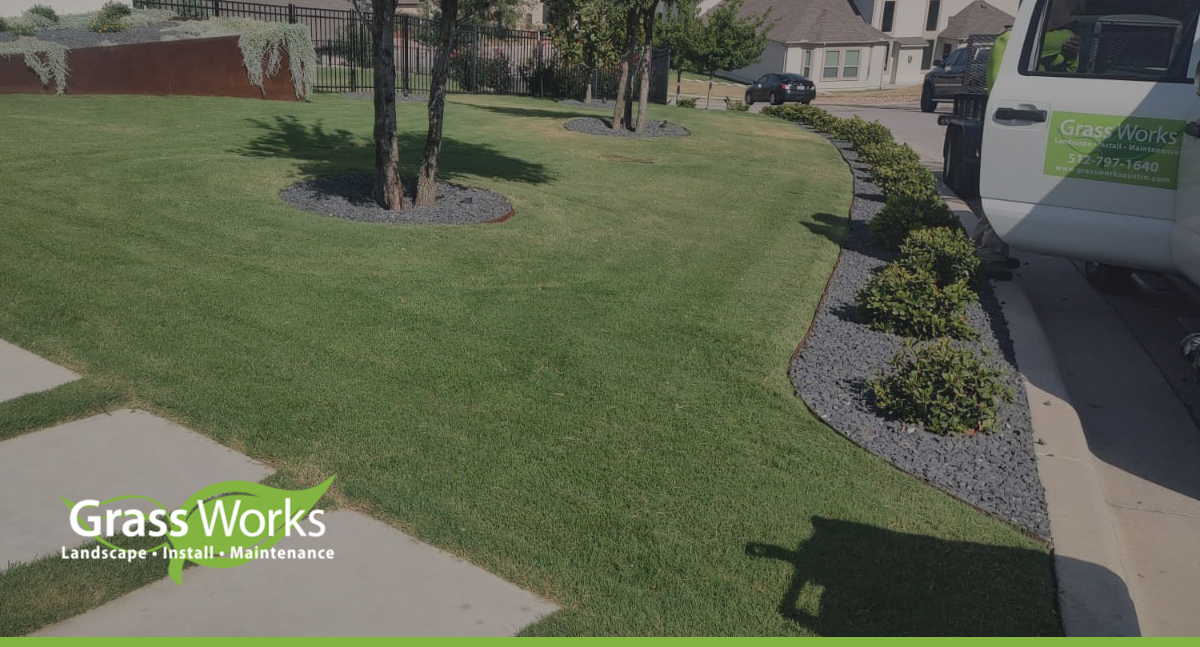How To Thicken St. Augustine Grass

St. Augustine is a warm-weather grass that is especially well-suited to Central Texas lawns. It’s known for its dense, thick growth and wide blades. St. Augustine grass typically forms a plush, turf-like lawn that’s ideal for residences and parks.
However, this grass is also somewhat high-maintenance. It needs regular fertilization, watering, and mowing to remain thick and strong. If you’re running into issues keeping your St. Augustine grass thick and healthy, here are a few pointers for getting it back in shape.
Test the Soil
St. Augustine grass thrives in well-irrigated, acidic to neutral soil. A good soil pH level for St. Augustine grass is generally between 5.0 and 8.5, ideally between 6.0 and 7.5. Use a testing kit or a digital pH meter to check your soil’s level.
If your lawn has patches or bare spots, add topsoil to them to prevent water from pooling. If your lawn is not properly draining or is composed of clay soil, try mixing and tilling it with compost or pine bark. Alternatively, you can aerate the soil with a garden fork, manual aerator, or core aerator machine.
Plant Early
The best time to plant St. Augustine grass is usually late spring to early summer before Central Texas temperatures heat up. This gives the grass enough time to establish deep roots. Make sure to plan the grass in full sun.
When properly planted, St. Augustine grass spreads quickly through runners both above the ground (stolons) and beneath (rhizomes). Planting the grass in autumn can also be a good option depending on the weather (as temperatures in the fall in Texas can vary year by year).
Use Fertilizer
The right fertilizer is crucial to ensure St. Augustine grass develops its roots and grows quickly. During the first two months of growth, use a phosphorus fertilizer that helps the grass grow deeper and establish roots. This, in turn, helps the grass to absorb water and nutrients.
After two months, switch to a nitrogen fertilizer. Nitrogen stimulates leaf growth and chlorophyll production, giving the blades a deep green color and supporting lush, thick growth. Use one pound of nitrogen fertilizer for every 1,000 square feet of lawn. Apply nitrogen fertilizer every two months, or use a slow-release fertilizer every ten weeks.
Set a Watering Schedule
Hydration is extremely important for St. Augustine grass. Keeping a regular watering schedule keeps the lawn from slipping into inactivity or death.
Start by watering twice a day for the first two weeks. Once roots are set, gradually decrease the watering to twice a week, leaving about 1/2 to 3/4 inches of water each time. Tip: A well-programmed irrigation system can simplify this.
Keep Up With Weeding and Mowing
Weeds and crabgrass have the same growing schedule as St. Augustine grass. To avoid competition for water and nutrients, take care of these weeds quickly to prevent their spread. Five weeks before planting, use a pre-emergent weed killer to control growth. For random, sporadic weeds, either pull them by hand or use a mild herbicide.
Only mow as the lawn needs it. Start by mowing it when the blades reach 2 1/2 to 4 inches, cutting no more than a third of the blades’ length. If the grass is mowed too low, it’s more vulnerable to damage. Mow sporadically, and water more if your St. Augustine grass seems stressed.
An Alternative to St. Augustine Grass
Although St. Augustine grass is popular and plentiful in Central Texas, it’s relatively high maintenance, requiring more frequent mowing and watering. Its quick spread can also be too assertive and threaten garden areas.
The Grass Works Lawn Care team recommends Palisades Zoysia grass as a worthy substitute. Its narrower blades and medium texture give the grass a softer feel underfoot, and it stands up to cold weather and drought conditions slightly better. Palisades Zoysia also thrives in more types of soil than St. Augustine grass. Think about switching before the growing season begins.
Grass Works has been providing Expert Residential & Commercial Local Lawn Care Services in Central Texas: Austin, Cedar Park, Round Rock, Avery Ranch, Bee Cave, Lakeway, Steiner Ranch & West Austin since 2007! Need help with your landscaping? Get a free estimate today!

Ferris MyCue is the founder and owner of Grass Works Lawn Care, LLC located in Leander, TX. As a former firefighter who maintained yards on his days off, he saw a need for a dependable, local maintenance company that knew the hill country climate and could deliver quality landscaping services for a reasonable price. Since 2007 he has used his leadership to grow the company into one of the top landscape maintenance companies in Austin and surrounding areas offering landscape maintenance, design, and irrigation services to both residential and commercial clients. Ferris is also a member of the Seasonal Employment Alliance (SEA) and an active participant in advocacy efforts to help promote cap relief.